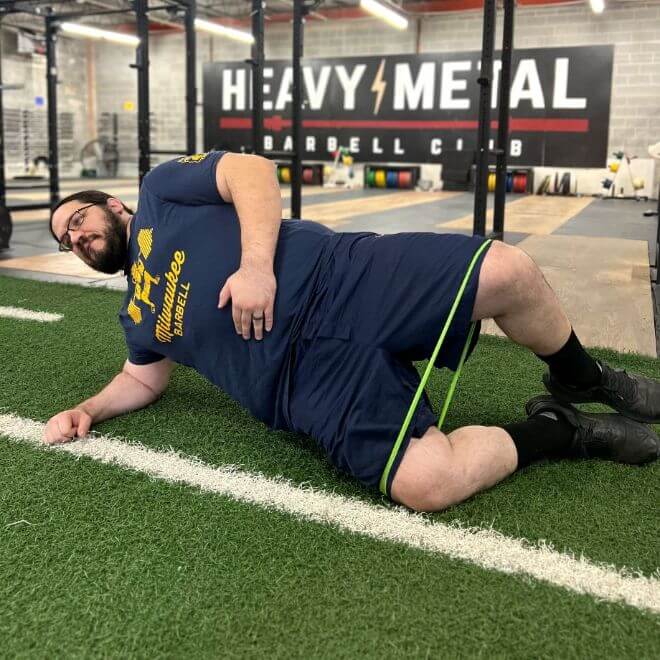We test and review fitness products based on an independent, multi-point methodology. If you use our links to purchase something, we may earn a commission. Read our disclosures.
As a strength athlete for over two decades of my life, I’ve gotten quite comfortable with heavy lifting and strength training. But I get it: Not everyone is as comfortable. Strength training can be intimidating. Honestly, for beginners I would typically recommend having a certified personal trainer around to teach you proper form and technique.
Another avenue for beginners is resistance band training. Resistance bands are a way to build muscle and improve flexibility, all while being less stress on the body and joints. Even if you are training at an intermediate or advanced level, I would recommend exercise bands for the variety it brings to a program. Variety is a vital part to any training program, so incorporating a different tool like resistance bands can go a long way.
Here, we will go into how these elastic bands can be great for your workout, as well as some of the best resistance band exercises that will be great for a quick, full-body workout to supplement any mode of training.
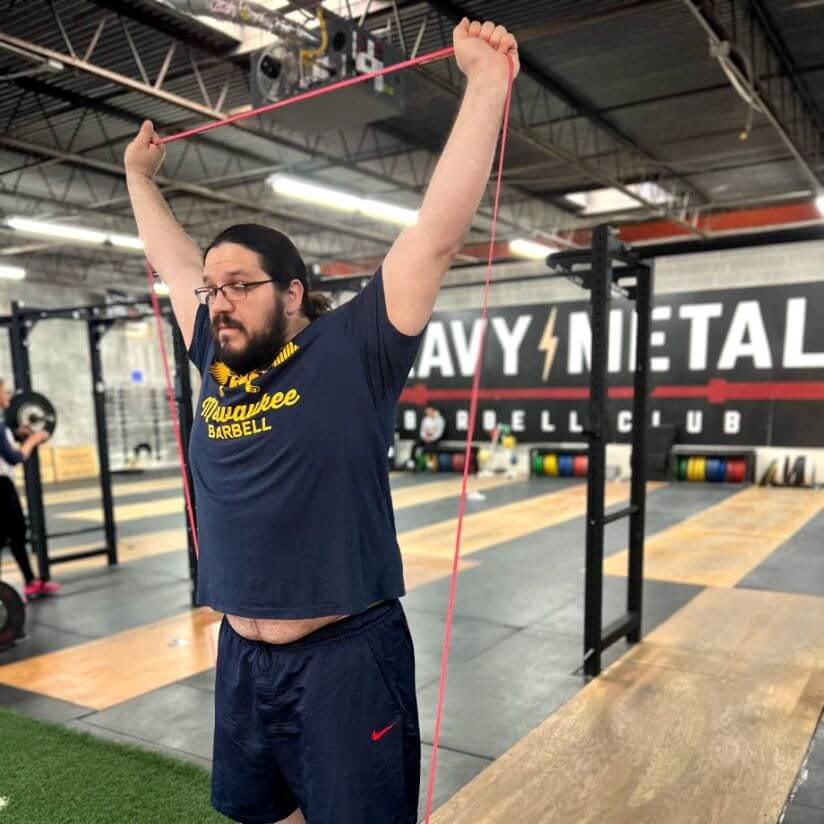
Why You Should Add Resistance Bands to Your Routine
Wondering why these affordable, portable tools are so great? Check out these resistance band benefits:
Build Muscle
Resistance band training can help tone and build muscle, along with your overall strength. A study from February 20191 shows that training with resistance bands can have similar gains in strength as conventional strength training. As the band is elongated, it has greater resistance, wanting to snap back to a resting position. This resistance is a stressor for the muscles, and will cause the same stimulus for adaptation as traditional weights. Plus resistance band training is versatile, so you can use them for a total body workout, toning muscle all along the way.
Improved Flexibility
Resistance bands are very commonly used in warming up and cooling down, due to their aid in stretching and improving flexibility. According to a March 2019 study2, habits like foam rolling and using elastic bands for mobility work can improve an athlete’s overall flexibility and range of motion. Additionally, certain resistance band exercises will train stabilizing muscles, ultimately improving stability and core strength.
Less Stress On the Joints
Instead of traditional heavy loads in strength training, using resistance band training can help you have less stress on the joints overall. Lighter loads will help keep tendons and ligaments strong throughout the movement. Also, resistance bands will also be an effective way to rehabilitate joint instabilities, according to an August 2020 study3.
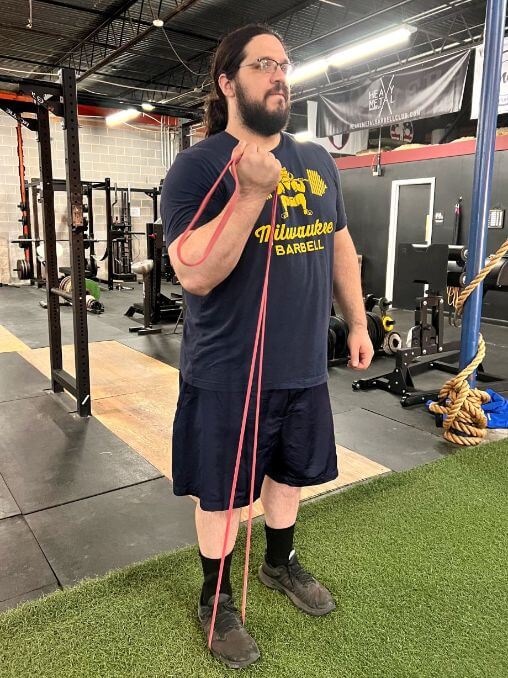
A Portable Workout
It’s hard to carry around dumbbells and barbells everywhere you go. Resistance bands, however, can be a great alternative to bring with you to get a workout in on the go. Bands can vary in length and size, but all are extremely portable and easy to carry around. They can also be a great source of a home workout if you don’t have the space for a home gym.
So what is stopping you? Let’s try these next resistance band exercises.
12 Resistance Band Exercises
There are countless exercises you can do with resistance bands, whether for cardio, strength, or even high-intensity interval training (HIIT). Here are a few of my favorites. You can use straight or long loop bands for these movements.
Resistance Band Lateral Raise
Why Do It: Lateral raises will get the shoulders burning quickly. Furthermore, proper lateral raises will also force you to maintain a strong core during the movement, which makes for a challenging functional movement.
How to Do It:
- Standing on the middle of a band with both feet, hold one end of the band with each hand. Make sure to have a tight, flexed torso to maintain your position throughout the movement.
- Start with your arms at your side, and then bring the arms up until they are parallel to the floor (or at shoulder height), keeping a slight bend in the arms throughout the movement.
- Hold the top for a moment, and then bring the arms back to your starting position.
- For variety, these can be done with one foot on the band, and one arm raising up at a time; this will get some unilateral movement in your routine, improving core strength. Perform all your reps on one side, and then switch sides.
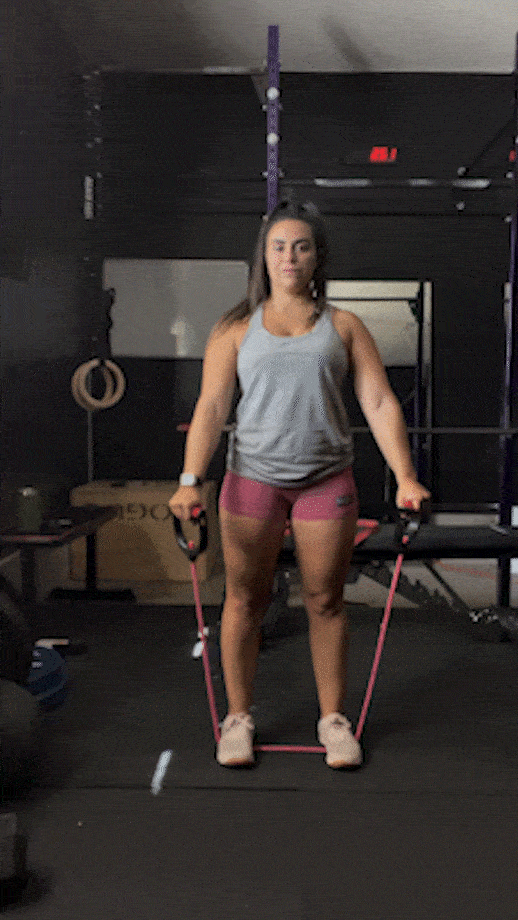
Resistance Band Squat
Why Do It: Squats are vital to almost any workout, and that’s not just the weightlifter in me talking. No matter how you do them, squats are one of the best exercises to build leg muscle. They also provide a lot of functionality, in how they address multiple muscle groups in your lower body, from the posterior chain and lower back, to the quads and calf muscles even.
How to Do It:
1. Begin with both feet on top of one end of a band, and then loop the other end over the head and on the back of the neck. Make sure that your stance is a typical squat position: just outside shoulder-width.
2. Keeping the torso tight and braced, bend at the hips and then knees to sit down towards the bottom of your squat, typically below parallel.
3. Fire back up to standing through the heels and glutes, pushing against the resistance of the band.
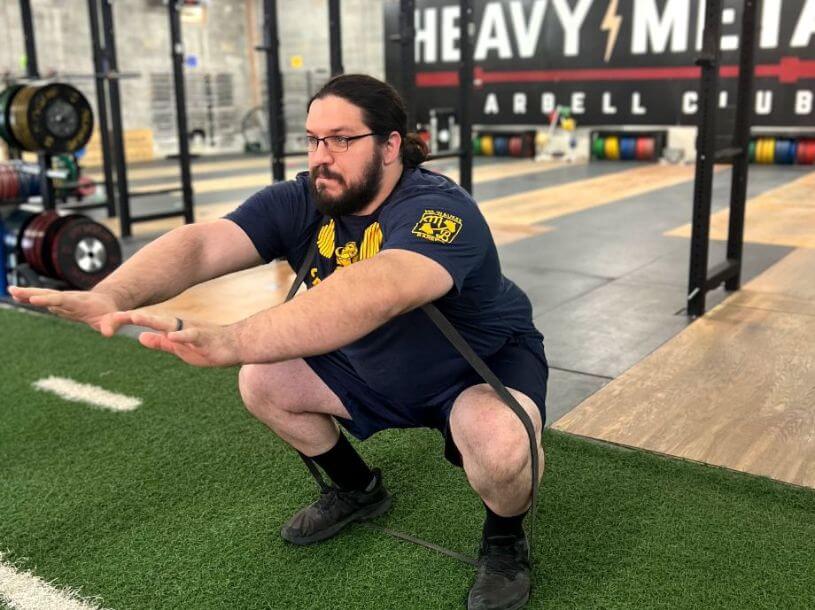
Resistance Band Clamshells
Why Do It: Clamshells will help work out the hips and thighs. Also, with the amount of work clamshells do for opening up the hips, this exercise can slowly but surely help increase mobility in any problem areas you may have in the hips.
How to Do It:
- Lay on your hip and your forearm, and have your legs bent, feet together, positioning a band around your thighs, just above the knees.
- While on the ground, lift the top knee up, opening up the hips.
- Hold for a moment, and then lower the knee back down.
- For an added challenge, you can raise the hip off the ground and be on your knee and forearm. This will engage your core more, making you do a side plank during the movement.
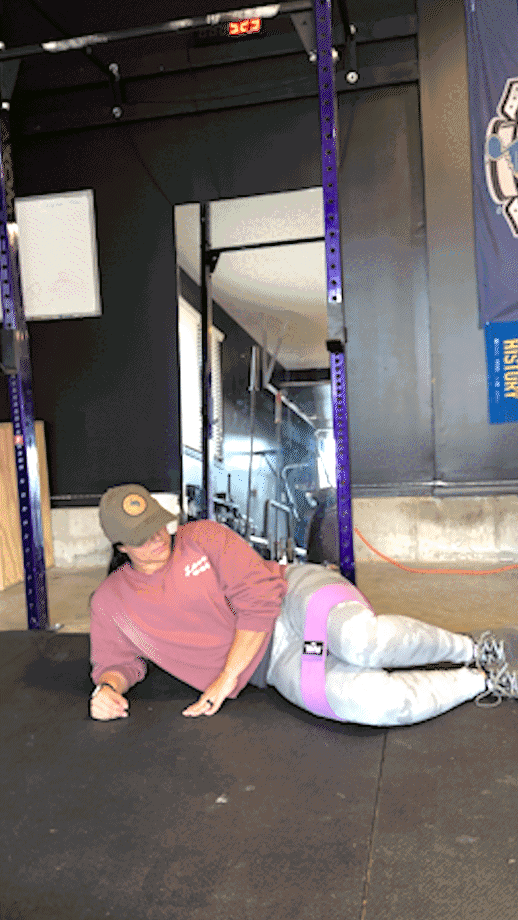
Resistance Band Row
Why Do It: Rows will get the spinal erectors and shoulder blades of the upper back engaged quickly and efficiently. A resistance band will also keep tension throughout the movement, making it a more challenging movement.
How to Do It:
- With both feet standing on the band, grab one end of the band with each hand. Shift the hips back as you bend over, keeping the core and lower back tight.
- Starting with the arms extended downwards, pull the bands up towards the chest, holding for a moment, and then lowering back to the starting position.
- This example is for a bent-over row; however, you may anchor the band to a wall or post at chest height and perform a standing row. Along with those, you could be seated on the floor with the band wrapped around the feet, pulling the band to your chest for a seated row.
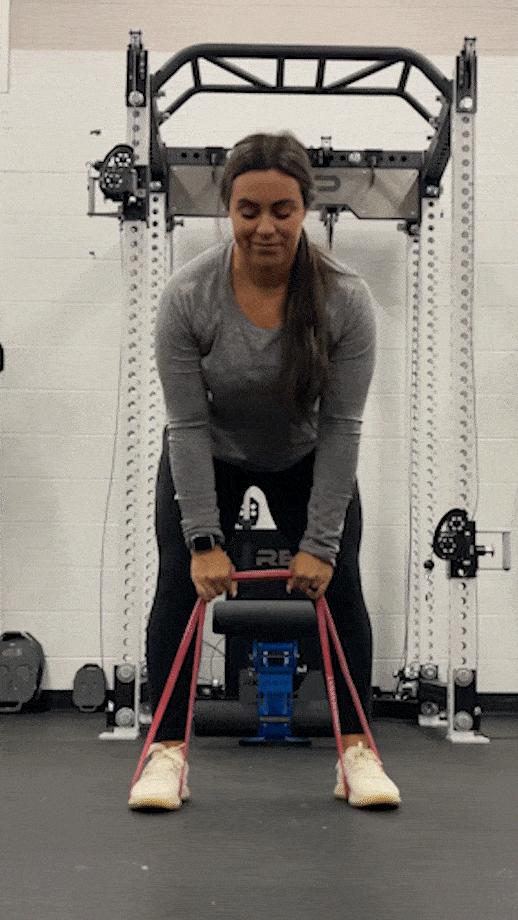
Resistance Band Deadlift
Why Do It: Deadlifts are a great focus on the posterior chain of the legs, helping build the hamstrings, glutes, and lower back. With banded resistance, this will also be less stress than a barbell deadlift typically is, making this a great alternative if the lower back is already feeling fatigued. (RELATED: Deadlift Muscles Worked)
How to Do It:
- Standing with a shoulder-width stance with both feet on a band, grip each end with a hand.
- To find your starting stance, lean over while shifting the hips back. There should be a little bend to the knees, and hips back, chest low.
- Holding the band, push through the feet to standing, firing through the glutes and hamstrings. Control the movement and keep the core strong throughout.
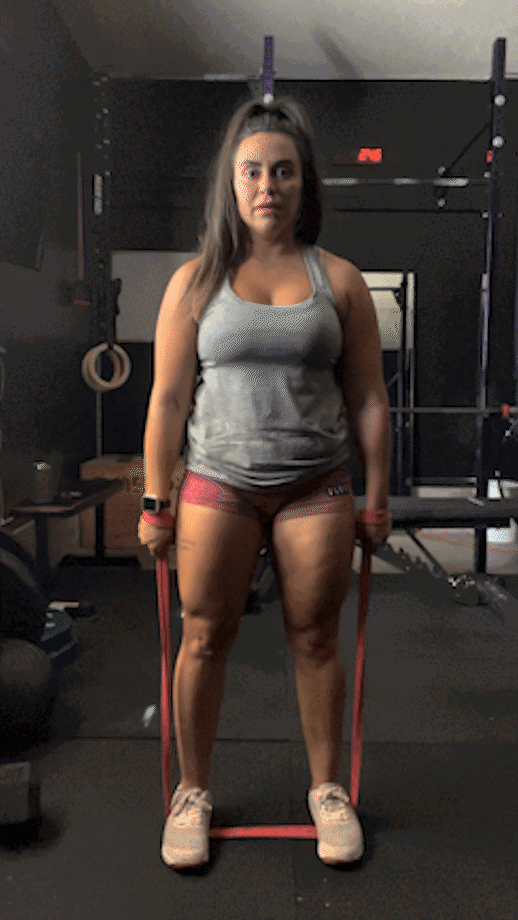
Resistance Band Press
Why Do It: A press is a staple in any upper body workout. This will mostly tackle the shoulders and a little bit of the triceps. Even with a chest press or bench press, the pecs will be used.
How to Do It:
- Standing on the band with both feet, hold each end of the elastic band with a hand. Have the hands up at shoulder height, with the elbows underneath.
- Press up with the shoulders, extending the arms all the way overhead.
- Hold for a moment, and then lower the arms back down.
- You can vary this overhead press by doing one arm at a time, to get the obliques firing in the core as well. Also, you can do a chest press, wrapping the band behind your back as you hold each end of the resistance band. Then, push the arms straight out forward at chest height.
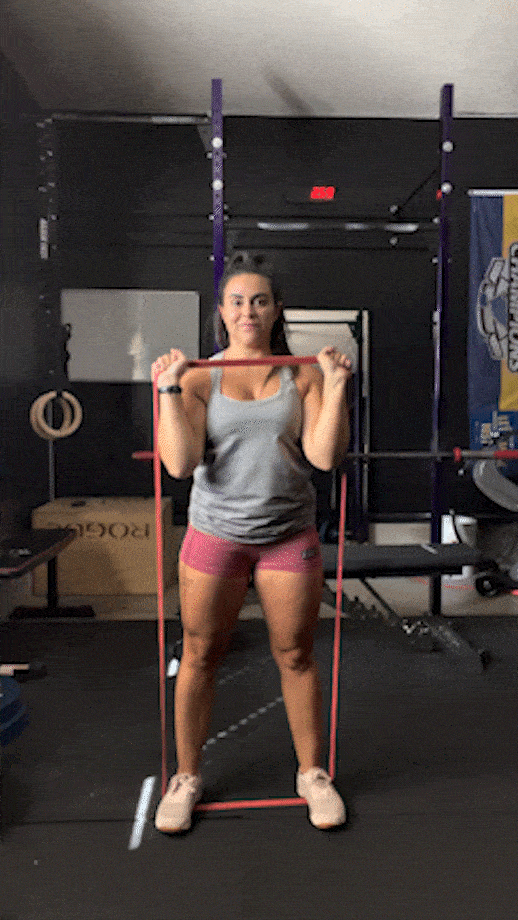
Resistance Band Lateral Walk
Why Do It: I use lateral walks as part of my warmup nearly every training session. This is because of how it directly addresses one of my problem areas: my hips. Activating and strengthening the hips with this simple movement helps build mobility and a better range of motion for any athlete.
How to Do It:
1. With a smaller band wrapped around the thighs – just above knee height – get set into a quarter squat. Feet will be outside shoulder-width, with a slight bend to the knees and hips, keeping the chest up.
2. While maintaining good posture in the upper body, take a short step to the side, pushing against the resistance band around the leg.
3. Take another small sidestep with the other leg, and continue for several reps, going the other way as well.
4. For more of a challenge, you can put the band around the ankles, increasing the resistance due to how much you are stretching the band.
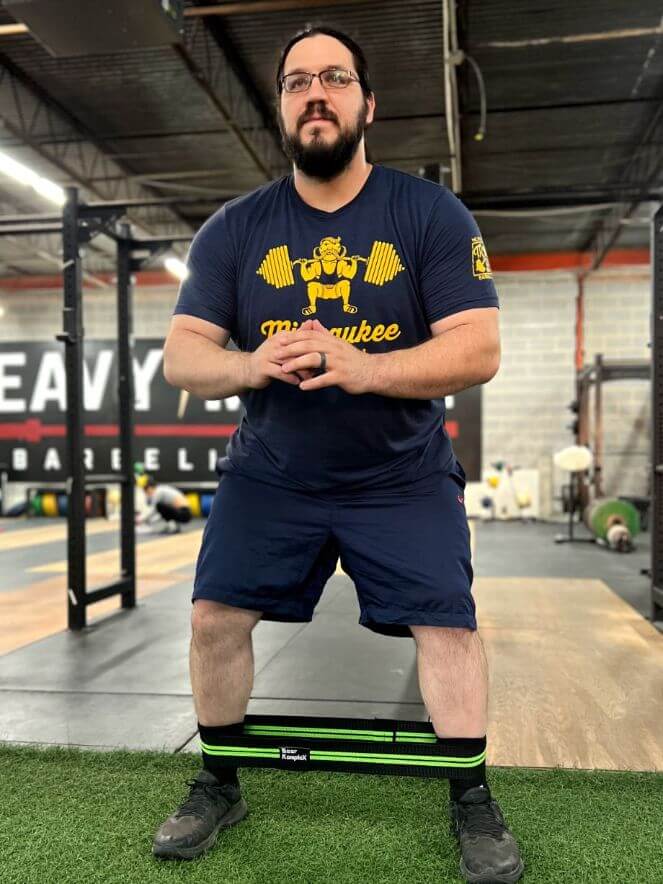
Resistance Band Biceps Curl
Why Do It: People don’t always recognize biceps curls as a functional movement, but in this case, I would argue they can be. A resistance band is going to allow for more unilateral training, and having to maintain balance and coordination. In addition, the elasticity of the band can help you keep constant tension on the muscle during the exercise. That makes this a very effective tool to build muscle in the arms.
How to Do It:
- Standing on the band, hold onto it with each hand, arms lowered by your side.
- Curl up the band, flexing the biceps and raising the forearm until it is to the chest.
- Hold this for a moment, and then lower the arms.
- It’s important to try to keep tension on resistance bands, and therefore your muscles, during these movements. If you are not feeling any tug or pull from the bands, grab the bands a little bit lower to shorten the slack and give on the elastic bands.
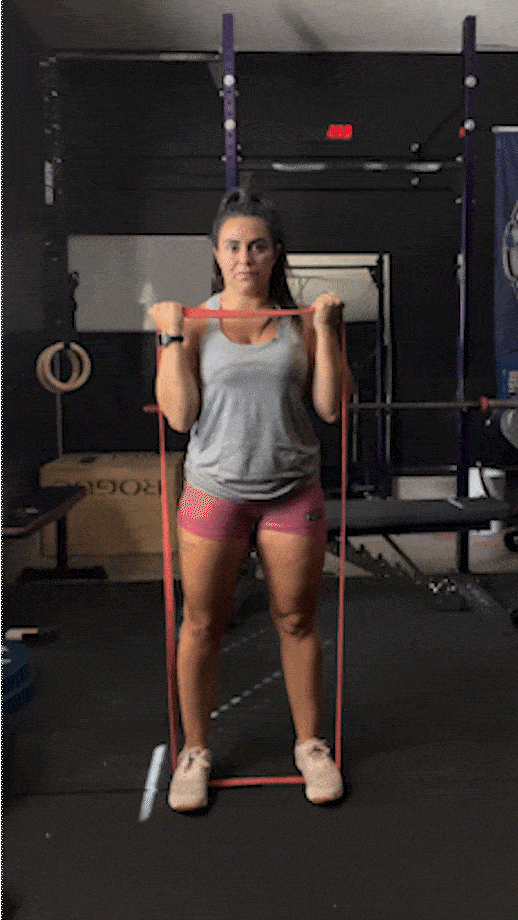
Resistance Band Triceps Extension
Why Do It: Triceps extensions address the back of the arms. Using this exercise is similar to the biceps curl; it’s a great movement that will work on the triceps, and use the added challenge of banded work to bring this exercise to another level.
How to Do It:
- Stand on the band with the heels of your feet.
- Keeping the band to the back of you, grab the other ends of the band and lift it up to behind your head, each hand gripping the band, and elbows up and high.
- Trying the keep the upper arms in place, extend the forearms all the way overhead,
- Hold this position for a moment, and then lower the arms back down to the starting position.
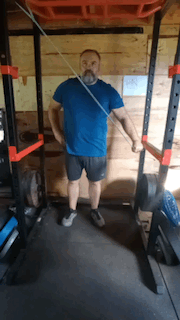
Resistance Band Bicycle Crunch
Why Do It: Bicycle crunches are a functional core exercise, giving a strong workout to one’s abdominals and obliques. Another added bonus is that with the resistance band, the bicycle crunch can also train and strengthen the hips and hip flexors.
How to Do It:
1. Place a smaller band around both feet, and then lay on the floor.
2. Assume a crunch position, with your legs up and bent, and the shoulders off the floor with the arms behind your head.
3. Maintaining the shoulders off the ground, twist one arm’s elbow to the opposite knee, as that leg crunches up, and the other leg extends. So, if I twist my left elbow over, then my right knee should crunch up as my left foot and leg extend down.
4. Alternate the movement. So in the previous example, the left leg and knee crunch, the right foot extends, and the right elbow reaches for the left knee.
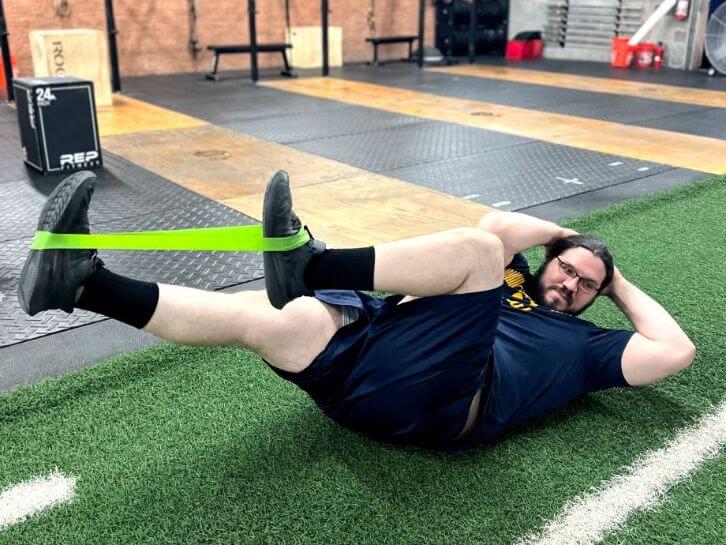
Resistance Band Pull-Apart
Why Do It: I have put banded pull-aparts in warm-ups for CrossFit classes for years. It’s a simple way to warm up and activate the upper back prior to a big workout. However, it has a lot of merit as its own exercise, too.
How to Do It:
- Hold one end of the resistance band with each hand. For a longer band, it might be preferable to grab more in towards the center of the band, as to increase the amount of tension.
- Hold the arms straight out in front of you at shoulder height.
- Then pull open the arms, keeping them straight, until they are at your side, still keeping at shoulder height.
- Return back to the starting position.

Resistance Band Glute Bridge
Why Do It: As with many of these exercises, the addition of a resistance band helps attack other muscle areas not typically seen without them. In this case, glute bridges are great to fry the glutes and posterior chain, but with a band around the knees, they also attack the hip mobility and strength, big time. This makes it a prime exercise, for me as well as anyone else needing strengthening in the hips and posterior chain.
How to Do It:
- Lay on the ground, with the legs bent, feet flat on the ground, along with the shoulders. Have a small band wrapped around the thighs, just above the knees.
- Flex the glutes to raise the hips off the ground, keeping the shoulders and feet touching the ground. Push with the glutes as high as you comfortably can.
- With the resistance band, make sure to keep pushing the knees out, as the band will want to push inward.
- Hold for a moment, and then relax the hips back to the floor.
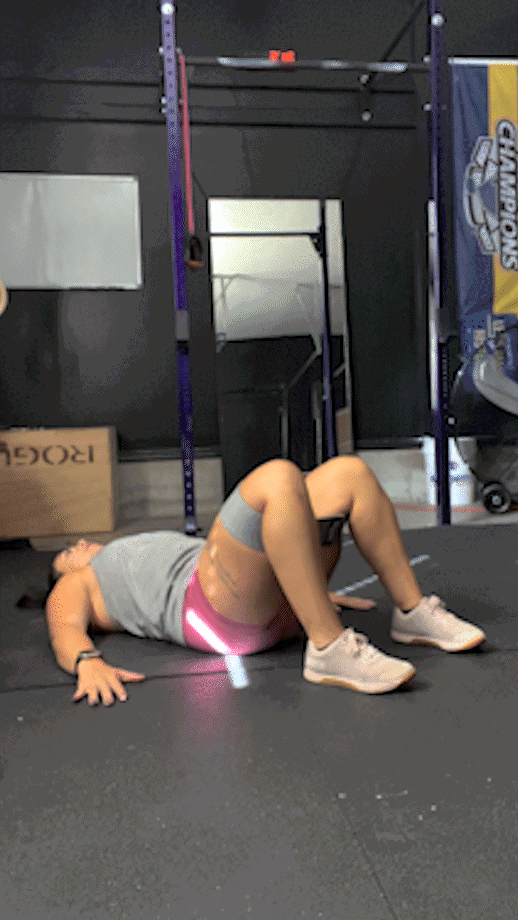
Resistance Band Workout: Q&A
Do resistance band workouts really work?
They do! Studies have shown that resistance band training can help build strength. Along with there being less stress on the joints than traditional weight training, this makes resistance band workouts an integral part of almost any workout.
Can you get ripped using just resistance bands?
It is possible to build muscle with just resistance bands. Resistance bands build strength and muscle in the same way that barbells, dumbbells, or kettlebells would. Bands create tension through their elastic nature, and with smart training, like increasing the thickness of the band to increase the amount of resistance (progressive overload), you can get toned easily with resistance bands.
How long should a resistance band workout be?
Workouts will vary from time to time, but typically, these workouts will last around 20 to 30 minutes. Try the exercises above; keep each exercise to three sets, keeping each between 10-20 reps. At that rep count, we are aiming for a challenging resistance that we are still able to move through well and quickly on each repetition.
References
- Lopes JSS, Machado AF, Micheletti JK, de Almeida AC, Cavina AP, Pastre CM. Effects of training with elastic resistance versus conventional resistance on muscular strength: A systematic review and meta-analysis. SAGE Open Med. 2019 Feb 19;7:2050312119831116. doi: 10.1177/2050312119831116. Erratum in: SAGE Open Med. 2020 Sep 9;8:2050312120961220. PMID: 30815258; PMCID: PMC6383082.
- Guillot A, Kerautret Y, Queyrel F, Schobb W, Di Rienzo F. Foam Rolling and Joint Distraction with Elastic Band Training Performed for 5-7 Weeks Respectively Improve Lower Limb Flexibility. J Sports Sci Med. 2019 Feb 11;18(1):160-171. PMID: 30787664; PMCID: PMC6370967.
- Cain MS, Ban RJ, Chen YP, Geil MD, Goerger BM, Linens SW. Four-Week Ankle-Rehabilitation Programs in Adolescent Athletes With Chronic Ankle Instability. J Athl Train. 2020 Aug 1;55(8):801-810. doi: 10.4085/1062-6050-41-19. PMID: 32577737; PMCID: PMC7462179.
Further reading

Looking to spice up your cardio with interactive programming? Our Echelon Connect EX-5 Bike review details just that. Read more

Chasing your tail trying to find the best pre-workout for running? Run, don't walk, to discover our expert-curated picks! Read more

When prioritizing your gut health, the last thing you want to deal with is probiotics side effects. Learn how to manage them from a registered dietitian! Read more

Few moves hit the obliques quite as well as the side crunch does. Find out how to do side crunches with proper form from our personal trainers! Read more

